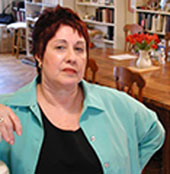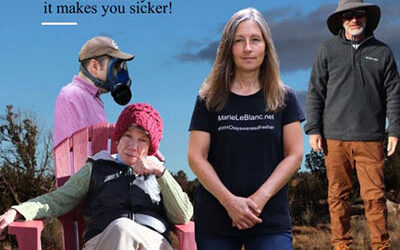by Phyllis Chesler
 These are plague years. Governments, insurance companies, even scientists—we, the people, too—are scared. Who’ll fall ill next, who’ll have to pay? What if the burden of caregiving is insupportable? What if there’s no cure? What if someone is heterosexual, middle-class, God-fearing, not an IV drug user, not a world traveler, not promiscuous, but suddenly, one day, is stricken with a mysterious illness? Panic in the streets? Hardly.
These are plague years. Governments, insurance companies, even scientists—we, the people, too—are scared. Who’ll fall ill next, who’ll have to pay? What if the burden of caregiving is insupportable? What if there’s no cure? What if someone is heterosexual, middle-class, God-fearing, not an IV drug user, not a world traveler, not promiscuous, but suddenly, one day, is stricken with a mysterious illness? Panic in the streets? Hardly.
The cruelty with which our society treats those we view as differently abled or mentally ill is painful to contemplate. The cruelty we reserve for those who may or may not be mentally ill, but who are suffering from a disabling, possibly infectious, illness for which there is no cure is overwhelming. “watch out, stand back.” We deny that such people are really ill. We say: If they are, it’s their own fault. They could get better if they tried.
Dr. Naomi Weisstein formerly directed a brain research laboratory. She had a stellar reputation. “In 1980 when I first became too weak and dizzy to get out of bed, friends and family visited,” she recalls. “But I didn’t get better. People got annoyed, suspicious. They felt powerless. Some people blamed me, which in this culture meant they attributed my illness to psychological causes. One good friend, a physician herself, decided that I’d become mentally ill. There could be no other explanation. She cut me loose. She told everyone we both knew that I was a crazy malingerer. When I finally found a doctor willing to consider that my overwhelming physical suffering reflected an organic, not mental disease, my own mother wrote to him to tell him that I was just being hysterical. Some of my friends have been absolutely unswerving in their loyalty and commitment. But for most people, their own terror keeps them from reaching out and staying connected to a plague victim.”
Aviva Rahmani, an artist and former dancer, always prided herself on a good appearance. “I moved through life with my whole body,” she says. “I was a very physical painter. I painted on large canvases. I walked fast. When I talked I gestured. I never hesitated. Then, one day, in 1991, I literally couldn’t get out of bed. I felt like I was in a waking coma. At first, I thought I was depressed. But I knew that I was sick beyond depression.”
That spring, I came down with a “flu” that would not go away. My throat was burning-sore, my glands swollen. I had either a low-grade fever or a killer night fever with extreme chills. I was dizzy, disoriented, sometimes nauseous, sometimes gripped by headaches. I had severe joint pain, unbearable muscle ache and muscle weakness (I kept dropping things), heightened sensitivity to light and sound, and a serious sleep disorder. I began suffering from first-time “allergies” and from repeated infections in my teeth, gums and jaws. In addition, my fatigue was overwhelming. I couldn’t walk to the corner store. It was even physically hard to get out of bed.
These physical symptoms were nowhere near as traumatic as the cognitive and neurological deficits I was experiencing. I would forget what I was about to say. I couldn’t remember, pronounce, or spell familiar names. I had trouble adding or multiplying simple sums. I confused “left” and “right.” I couldn’t read more than a few pages a day. Such cognitive deficits would frighten anyone; they terrified me. I am used to reading the equivalent of a book a day, writing 20-40 pages daily of manuscript and correspondence, and having at least one, often two, working meetings, in addition to lecturing.
Hardly a week passed without someone calling to say: “Listen, my brother-in-laws cousin said a friend of hers also thought she had this, but it turned out to be—the list was endless: parasites, allergies, candida, repressed incest, a brain tumor, a thyroid problem, depression, menopause.”
Since the mid-1980s my illness (Weisstein’s and Rahmani’s too) has come to be known as Chronic Fatigue and Immune Dysfunction Syndrome: CFIDS or CFS, or Myalgic Encephalomyelitis (ME), Epstein-Barr virus, or “yuppie flu.” In the mid-1980s, physicians here and all over the world first began seeing cluster outbreaks of this illness among urban and rural, young and middle-aged, rich and poor, men and women: pilots, housewives, athletes, doctors, nurses, bankers, secretaries, academics, teachers and even children.
Some physicians became alarmed. Most were not believed. For example, in 1985, Dr. Paul Cheney, practicing in Incline Village, Nevada, persuaded the Centers for Disease Control and Prevention to interview his patients. The CDC excluded all those patients who subsequently developed cancer, or who had seizures, as suffering from these post-CFIDS complications, and not from CFIDS itself. The CDC and the National Institutes for Health insisted that what these physicians were seeing was really a psychiatric condition, not a real, i.e., infectious or viral illness. Dr. Stephen Straus, the director of virology at the National Institute of Allergy and Infectious Diseases, concluded that CFIDS was primarily psychiatric or “psycho-neurotic.” His views have been seconded by many psychiatrists, both here and abroad, and often, but not always by journalists.
As a professor of psychology, a psychotherapist and courtroom witness, I am an expert in how frequently women are diagnosed as mentally ill when they are not. I also know that mental illness is real and deserves our compassion and understanding, as well as state-of-the-art treatment.
When I first explored sexist bias among mental-health professionals in Women and Madness in 1972, I did not realize that when western medicine does not understand and/or cannot cure an illness, it first denies that the illness is real by saying it is merely a psychiatric disorder. Once asthma, arthritis, lupus, multiple sclerosis, Lyme’s disease, allergies and Gulf War Syndrome too—were dismissed as primarily psychiatric in nature. Patients were told they were exaggerating or imagining things.
While I would like to believe that psyche and soma are one, I also know that viruses, parasites, bacteria, funguses, sexually transmitted diseases and toxic chemicals are real, and can also cause neurological and cognitive dysfunction. I know that depression is often a secondary symptom of chronic pain.
We do not know whether CFIDS is caused by a virus or a retro-virus, is or is not infectious, or is or is not an acquired immunodeficiency or whether it is due to other, unknown causes. We do know that there has been research—underreported by the media—which demonstrates that the illness has an organic basis.
For example, in 1994, Dr. Mark Demitrack, a clinical research physician at the Lilly Research Laboratories and adjunct associate professor of psychiatry at the University of Michigan Medical Center, compared CFIDS and psychiatric patients. He discovered that in the CFIDS patients, the hypothalamic- pituitary-adrenal axis (DHEA) is significantly lowered. Depressed patients in that study showed exactly the reverse—they have significantly high DHEA levels. In addition, other studies have shown brain abnormalities. Brain lesions are evidenced on MRI. In a 1992 study brain perfusions, which resemble those seen in AIDS and in Alzheimer’s—although reversible in a CFIDS patient—were detected. This means that less blood is getting to the brain of a CFIDS patient.
Other studies have demonstrated that CFIDS patients have statistically low levels of the hormone cortisol; statistically high (abnormal) levels of immunological titres in blood samples; and, in some cases, neurally mediated hypotension. University of Miami immunologist Dr. Nancy Kilmas has shown that CFIDS patients suffer a greater deficiency of natural killer cells (which control viruses and cancers), than AIDS patients do. Dr. L.O. Simpson, a research fellow at Otago Medical School in Dunedin, New Zealand, has found a consistent red blood cell abnormality in the blood of both Gulf War Syndrome and CFIDS patients. This abnormality results in an inadequate delivery of oxygen, nutrients, chemicals, to muscles and tissues, following exertion.
The first of many physicians my disability insurance company ordered me to see said that I did not have CFIDS. He insisted that CFIDS did not really exist, or, if it did, was rare — but that I might be suffering from a psychiatric ailment. The second disability company physician said that if I could turn up for an office visit and wait for hours in her office, that I could not be “that sick.” The company insisted that I see a psychiatrist.
He diagnosed me too—with an unnecessary amount of vitriol and misogyny—as “practically psychotic.” Perhaps he thought he was doing me a favor. He’d said that the only way he ever got an insurance company to cover his early AIDS patients was if he’d diagnosed them as psychiatrically impaired. A year later, when the company forced me to see him again, this psychiatrist pronounced me “completely cured.”
Surely, the man deserves a Nobel Prize for being able to cure psychosis within a year and in only two visits! Sadly, being psychiatrically diagnosed did not cure me. No matter how dutifully I took the recommended low dosage of antidepressants prescribed by my internist my physical symptoms never went away. The medication allowed me to sleep, for which I was exceedingly grateful. Some physicians believe that some antidepressants are effective because they also have antiviral effects.
I and many others have also had to live with the myth that CFIDS is caused by stress. It is true: physical and psychological suffering are stressful. I believe that one has to be healthy, not impaired, to be able to handle normal, ordinary stress. I believe that CFIDS (and other disabled) patients are often subjected to a level of stress that is more than a healthy person can bear.
It is stressful not to be able to work, earn money, see friends, take a vacation, even take a walk. Many (not all) CFIDS sufferers became ill in their prime, many (not all) were formerly highly productive people. Once stricken, you cannot predict how you will feel on any given day, you cannot honor even cherished commitments—or can do so only at great cost: a week or a month in bed afterward. That’s stressful, as is learning how to accept the fact that you may be permanently disabled.
It is stressful to be forced to cash in your life insurance policy, mortgage your home to the hilt, spend all your savings, borrow from everyone you know, be denied your rightful health and disability benefits or forced to fight for them precisely when you are totally incapacitated.
It is stressful to be interrogated by hostile insurance company bureaucrats who talk to you as if you’re an imbecile—or a corporate adversary. Imagine trying to sue for your benefits when you are sick; imagine confronting company lawyers and executives, who are not only robust and healthy, but who can bring all their considerable resources to bear against your individual claim.
It is stressful when you can’t afford traditional or experimental western medications. Above all, it is stressful if you don’t have the money for so-called alternative (which are really ancient, traditional, oriental and natural) approaches to illness such as acupuncture, chiropractic, Chinese herbs and dietary supplements.
I have learned to live with this illness. I have a CFIDS specialist and a primary-care physician who believe that CFIDS is real, are fully familiar with the standard and experimental western medications such as ampligen, gamma globulin, cudapressin, lydocaine, fluorinef, neurontin, antidepressants, and who also prescribe the so-called alternative treatments. I have befriended others who also suffer from CFIDS with whom I can joke about my symptoms and exchange information about what works.
Last year, I published a letter in The New York Times criticizing a column on CFIDS. I was asked to join a by-invitation only e-mail group of physicians, medical researchers and mental health professionals who themselves suffer from CFIDS. This group constitutes a magnificent think tank and data bank. The members are exceedingly well informed, sophisticated, philosophical, compassionate, super-capable of critiquing the latest study or media coverage of that study, capable of calling for studies that have not yet been done.
I’ve learned to listen to my body, not to push it. I have just returned to full-time university teaching and writing. I am lucky, blessed, to be able to do so. And, it turns out: All this time, I had Lyme’s Disease too. I am now flourishing on antibiotics. (Like some others, my blood tests always yielded a false negative).
There are those who trust our government and God; they know best. If there’s a plague in our midst, surely, the authorities would warn us. Perhaps, perhaps not. In the 1930s, our tax dollars subsidized government scientists who experimented on human beings—the Tuskegee study in which antibiotics were withheld from African-American men with syphilis and from their wives in order to chart the course of the disease. In the same and subsequent decades, African-American women were experimentally lobotomized at state asylums. In the 1940s and 1950s, U.S. government scientists injected plutonium and uranium into uninformed prisoners and non-prisoners alike. In the 1960s, government scientists gave mentally retarded children radioactive cereal; and in the 1970s, they exposed university residents to radiation for studies on radiation poisoning.
They didn’t tell, we didn’t ask. For years, our government denied the facts of Vietnam’s Agent Orange and the Gulf War’s sarin nerve gas and pesticides. Military computer logs were destroyed: The dog ate my homework.
Conspiracies? Cover ups? Sometimes. More often, the enemies are ignorance, terror, denial, incompetence, passivity, greed.
Years ago, my friend, the writer Susan Griffin, wrote that “In a terrible way, no one who has CFIDS is truly alone. Sadly, we are all part of this global process. Those who are ill [are] like canaries in the mine—our sickness a signal of the sickness of the planet. An epidemic of breast cancer, the rising rate of lupus, MS, a plethora of lesser-known disorders of the immune system.” Perhaps she was right.
Phyllis Chesler, a professor of psychology and cofounder of the Association for Women in Psychology, is the author of eight books, including Women and Madness.










0 Comments